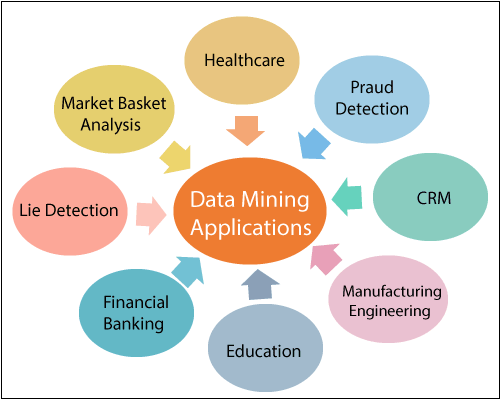Data mining is a process used by companies to turn raw data into useful information. By using software to look for patterns in large batches of data, businesses can learn more about their customers to develop more effective marketing strategies, increase sales and decrease costs. Data mining depends on effective data collection, warehousing, and computer processing.
Data Mining is defined as extracting information from huge sets of data. In other words, we can say that data mining is the procedure of mining knowledge from data. The information or knowledge extracted so can be used for any of the following applications:
- Market Analysis
- Fraud Detection
- Customer Retention
- Production Control
- Science Exploration
Data Mining Working
Data mining involves exploring and analyzing large blocks of information to glean meaningful patterns and trends. It can be used in a variety of ways, such as database marketing, credit risk management, fraud detection, spam Email filtering, or even to discern the sentiment or opinion of users.
The data mining process breaks down into five steps. First, organizations collect data and load it into their data warehouses. Next, they store and manage the data, either on in-house servers or the cloud. Business analysts, management teams and information technology professionals access the data and determine how they want to organize it. Then, application software sorts the data based on the user’s results, and finally, the end-user presents the data in an easy-to-share format, such as a graph or table.

Data Warehousing and Mining Software
Data mining programs analyze relationships and patterns in data based on what users request. For example, a company can use data mining software to create classes of information. To illustrate, imagine a restaurant wants to use data mining to determine when it should offer certain specials. It looks at the information it has collected and creates classes based on when customers visit and what they order.
In other cases, data miners find clusters of information based on logical relationships or look at associations and sequential patterns to draw conclusions about trends in consumer behavior.
Warehousing is an important aspect of data mining. Warehousing is when companies centralize their data into one database or program. With a data warehouse, an organization may spin off segments of the data for specific users to analyze and use.
However, in other cases, analysts may start with the data they want and create a data warehouse based on those specs. Regardless of how businesses and other entities organize their data, they use it to support management’s decision-making processes.
Example of Data Mining
Grocery stores are well-known users of data mining techniques. Many supermarkets offer free loyalty cards to customers that give them access to reduced prices not available to non-members. The cards make it easy for stores to track who is buying what, when they are buying it and at what price. After analyzing the data, stores can then use this data to offer customers coupons targeted to their buying habits and decide when to put items on sale or when to sell them at full price.
Data mining can be a cause for concern when a company uses only selected information, which is not representative of the overall sample group, to prove a certain hypothesis.
Data mining Tools and Techniques
Data mining techniques are used in many research areas, including mathematics, cybernetics, genetics and marketing. While data mining techniques are a means to drive efficiencies and predict customer behavior, if used correctly, a business can set itself apart from its competition through the use of predictive analysis.
Web mining, a type of data mining used in customer relationship management, integrates information gathered by traditional data mining methods and techniques over the web. Web mining aims to understand customer behavior and to evaluate how effective a particular website is.
Other data mining techniques include network approaches based on multitask learning for classifying patterns, ensuring parallel and scalable execution of data mining algorithms, the mining of large databases, the handling of relational and complex data types, and machine learning. Machine learning is a type of data mining tool that designs specific algorithms from which to learn and predict.
Benefits of Data Mining
In general, the benefits of data mining come from the ability to uncover hidden patterns and relationships in data that can be used to make predictions that impact businesses.
Specific data mining benefits vary depending on the goal and the industry. Sales and marketing departments can mine customer data to improve lead conversion rates or to create one-to-one marketing campaigns. Data mining information on historical sales patterns and customer behaviors can be used to build prediction models for future sales, new products and services.
Companies in the financial industry use data mining tools to build risk models and detect fraud. The manufacturing industry uses data mining tools to improve product safety, identify quality issues, manage the supply chain and improve operations.
One thought on “Data Mining”